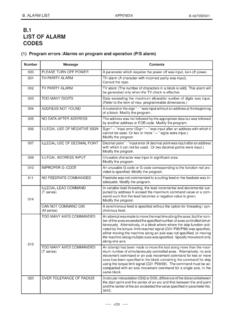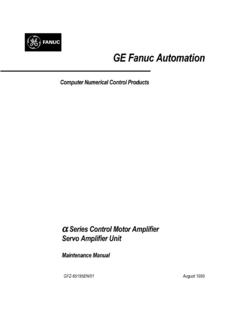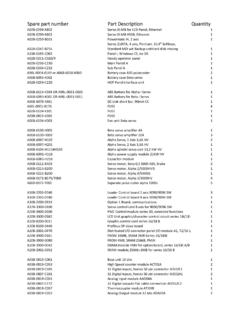Transcription of TROUBLESHOOTING AND ACTION - Fanuc Parts In Stock, …
1 TROUBLESHOOTING AND ACTION . Fanuc SERIES ALPHA-i servo AMPLIFIER MODULE. Model Order Specification SVM1-20 i A06B-6114-H103. SVM1-40 i A06B-6114-H104. SVM1-80 i A06B-6114-H105. SVM1-160 i A06B-6114-H106. SVM2-4/4 i A06B-6114-H201. SVM2-20/20 i A06B-6114-H205. SVM2-20/40 i A06B-6114-H206. SVM2-40/40 i A06B-6114-H207. SVM2-40/80 i A06B-6114-H208. SVM2-80/80 i A06B-6114-H209. SVM2-80/160 i A06B-6114-H210. SVM2-160/160 i A06B-6114-H211. SVM3-4/4/4 i A06B-6114-H301. SVM3-20/20/20 i A06B-6114-H303. SVM3-20/20/40 i A06B-6114-H304. Alarm Code 1.
2 (1)Meaning Inverter: internal cooling fan stopped (2)Cause and TROUBLESHOOTING (a)Check whether there is any foreign material in the fan. (b)Check that the fan connector is attached correctly. (c)Replace the fan. (d)Replace the SVM. Alarm Code 2. (1)Meaning Inverter: control power supply under voltage (2)Cause and TROUBLESHOOTING (a)Check the three-phase input voltage of the amplifier (the voltage shall not be lower than 85% of the rated input voltage). (b)Check the 24 V power supply voltage output from the PSM (the voltage shall normally not lower than V).
3 (c)Check the connector and cable (CXA2A/B). (d)Replace the SVM. Alarm Code 5. (1)Meaning Inverter: DC link under voltage (2)Cause and TROUBLESHOOTING (a) Check that the screws for the DC link connection cable (bar) are tight. (b)If a DC link low voltage alarm condition occurs in more than one module, see Subsection , "Alarm code 4" for explanations about how to troubleshoot the power supply module. (c)If a DC link low voltage alarm condition occurs in only one SVM, replace that SVM. Alarm Code 6. (1)Meaning Inverter: overheat (2)Cause and TROUBLESHOOTING (a)Check that the motor is being used at or below its continuous rating.
4 (b)Check that the cooling capacity of the cabinet is sufficient (inspect the fans and filters). (c)Check that the ambient temperature is not too high. (d)Replace the SVM. Alarm Code F. (1)Meaning Inverter: cooling fan stopped of the radiator (2)Cause and TROUBLESHOOTING (a)Check whether there is any foreign material in the fan. (b)Check that the fan connector is attached correctly. (c)Replace the fan. (d)Replace the SVM. Alarm Code P. (1)Meaning Communication error between amplifier and module (2)Cause and TROUBLESHOOTING (a)Check the connector and cable (CXA2A/B).
5 (b)Replace the control printed-circuit board. (c)Replace the SVM. Alarm Code 8. (1)Meaning Inverter: DC link current alarm (2)Cause and TROUBLESHOOTING (a)Disconnect the motor power leads from the SVM, and release the SVM from an emergency stop condition. <1>If no abnormal DC link current alarm condition has occurred. Go to (b). <2>If an abnormal DC link current alarm condition has occurred. Replace the SVM. (b)Disconnect the motor power leads from the SVM, and check the insulation between PE and the motor power lead U, V, or W. <1>If the insulation is deteriorated.
6 Go to (c). <2>If the insulation is normal. Replace the SVM. (c)Disconnect the motor from its power leads, and check whether the insulation of the motor or power leads is deteriorated. <1>If the insulation of the motor is deteriorated. Replace the motor. <2>If the insulation of any power lead is deteriorated. Replace the power lead. Alarm Code (1)Meaning Inverter: IPM alarm (2)Cause and TROUBLESHOOTING (a)Disconnect the motor power leads from the SVM, and release the SVM from an emergency stop condition. <1>If no IPM alarm condition has occurred.
7 Go to (b). <2>If an IPM alarm condition has occurred. Replace the SVM. (b)Disconnect the motor power leads from the SVM, and check the insulation between PE and the motor power lead U, V, or W. <1>If the insulation is deteriorated. Go to (c). <2>If the insulation is normal. Replace the SVM. (c)Disconnect the motor from its power leads, and check whether the insulation of the motor or power leads is deteriorated. <1>If the insulation of the motor is deteriorated. Replace the motor. <2>If the insulation of any power lead is deteriorated.
8 Replace the power lead. Alarm Code (1)Meaning Inverter: IPM alarm (OH). (2)Cause and TROUBLESHOOTING (a)Check that the heat sink cooling fan is running. (b)Check that the motor is being used at or below its continuous rating. (c)Check that the cooling capacity of the cabinet is sufficient (inspect the fans and filters). (d)Check that the ambient temperature is not too high. (e)Replace the SVM. Alarm Code bcd (1)Meaning Abnormal inverter motor current (2)Cause and TROUBLESHOOTING (a)Checking the servo parameters Referring to " Fanuc AC.
9 servo MOTOR i series Parameter Manual (B-65270EN)," check whether the following parameters have default values. Fanuc -15i PRM 1809, 1852, 1853. Fanuc -16i/18i/21i PRM & Power Mate i , 2040, 2041. Alternatively, if an abnormal motor current alarm condition occurs only on rapid acceleration/deceleration, it is likely that the motor is being used under too harsh a condition. Increase the acceleration/deceleration time constant, and see what will occur. (b)Disconnect the motor power leads from the SVM, and release the SVM from an emergency stop condition.
10 <1>If no abnormal motor current occurs Go to (c). <2>If an abnormal motor current occurs Replace the SVM. (c)Disconnect the motor power leads from the SVM, and check the insulation between PE and the motor power lead U, V, or W. <1>If the insulation is deteriorated Go to (d). <2>If the insulation is normal Replace the SVM. (d)Disconnect the motor from its power leads, and check whether the insulation of the motor or power leads is deteriorated. <1>If the insulation of the motor is deteriorated Replace the motor. <2>If the insulation of any power lead is deteriorated.











